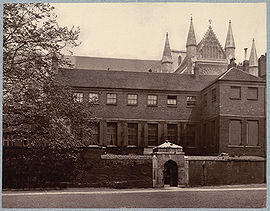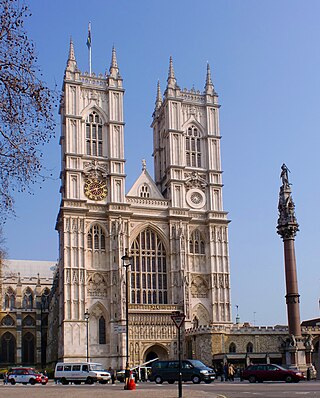
Westminster Abbey, formally titled the Collegiate Church of Saint Peter at Westminster, is an Anglican church in the City of Westminster, London, England. Since 1066, it has been the location of the coronations of 40 English and British monarchs, and a burial site for 18 English, Scottish, and British monarchs. At least 16 royal weddings have taken place at the abbey since 1100.
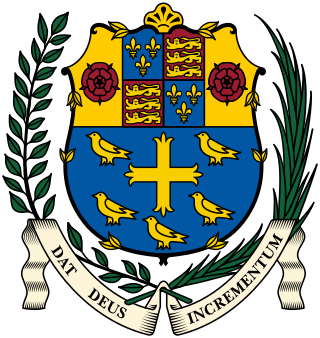
Westminster School is a public school in Westminster, London, England, in the precincts of Westminster Abbey. It descends from a charity school founded by Westminster Benedictines before the Norman Conquest, as documented by the Croyland Chronicle and a charter of King Offa. Continuous existence is clear from the early 14th century. Its academic results place it among the top schools nationally; about half its students go to Oxbridge, giving it the highest national Oxbridge acceptance rate. In the 2023 A-Levels, the school saw 82.3 of its candidates score A*/A.

Richard Bentley FRS was an English classical scholar, critic, and theologian. Considered the "founder of historical philology", Bentley is widely credited with establishing the English school of Hellenism. In 1892, A. E. Housman called Bentley "the greatest scholar that England or perhaps that Europe ever bred".
This article contains information about the literary events and publications of 1731.

Netley Abbey is a ruined late medieval monastery in the village of Netley near Southampton in Hampshire, England. The abbey was founded in 1239 as a house for monks of the austere Cistercian order. Despite royal patronage, Netley was never rich, produced no influential scholars nor churchmen, and its nearly 300-year history was quiet. The monks were best known to their neighbours for the generous hospitality they offered to travellers on land and sea.

Richard Busby was an English Anglican priest who served as head master of Westminster School for more than fifty-five years. Among the more illustrious of his pupils were Christopher Wren, Robert Hooke, Robert South, John Dryden, John Locke, Matthew Prior, Henry Purcell, Thomas Millington and Francis Atterbury.
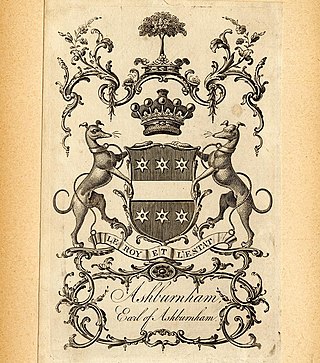
Earl of Ashburnham, of Ashburnham in the County of Sussex, was a title in the Peerage of Great Britain created in 1730 for John Ashburnham, 3rd Baron Ashburnham, who was also created Viscount St Asaph, in Wales.

A chapter house or chapterhouse is a building or room that is part of a cathedral, monastery or collegiate church in which meetings are held. When attached to a cathedral, the cathedral chapter meets there. In monasteries, the whole community often met there daily for readings and to hear the abbot or senior monks talk. When attached to a collegiate church, the dean, prebendaries and canons of the college meet there. The rooms may also be used for other meetings of various sorts; in medieval times monarchs on tour in their territory would often take them over for their meetings and audiences. Synods, ecclesiastical courts and similar meetings often took place in chapter houses.
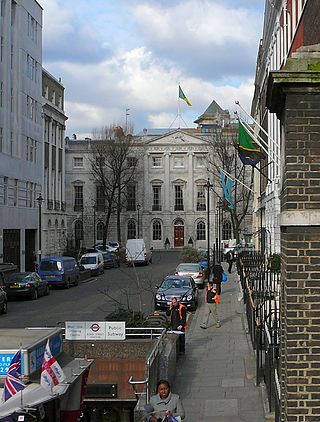
Stratford Place is a small road in London, off Oxford Street, opposite Bond Street underground station. The road is a cul-de-sac.

The Cotton or Cottonian library is a collection of manuscripts that came into the hands of the antiquarian and bibliophile Sir Robert Bruce Cotton MP (1571–1631). The collection of books and materials Sir Robert held is one of the three "foundation collections" of the British Museum in 1753. It is now one of the major collections of the Department of Manuscripts of the British Library. Cotton was of a Shropshire family who originated near Wem and were based in Alkington and employed by the Geneva Bible publisher, statesman and polymath Sir Rowland Hill in the mid 16th century.
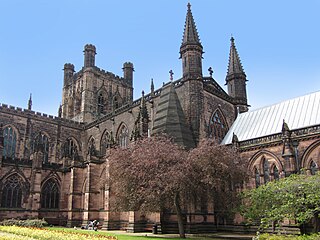
Chester Cathedral is a Church of England cathedral and the mother church of the Diocese of Chester. It is located in the city of Chester, Cheshire, England. The cathedral, formerly the abbey church of a Benedictine monastery dedicated to Saint Werburgh, is dedicated to Christ and the Blessed Virgin Mary. Since 1541, it has been the seat of the Bishop of Chester.

George William Kitchin was the first Chancellor of the University of Durham, from the institution of the role in 1908 until his death in 1912. He was also the last Dean of Durham to govern the university.

Titchfield Abbey is a medieval abbey and later country house, located in the village of Titchfield near Fareham in Hampshire, England. The abbey was founded in 1222 for Premonstratensian canons, an austere order of priests. The abbey was a minor house of its order, and became neither wealthy nor influential during its three centuries of monastic life; the inhabitants were devoted to scholarship, as shown by their very impressive library.

Little Dean's Yard, known to Westminster School just as Yard, is a private gated yard at the heart of the school, within the precincts of the monastery of Westminster and on the original Thorney Island, now shared between Westminster Abbey and the Palace of Westminster.
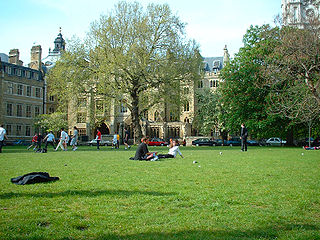
Dean's Yard, Westminster, comprises most of the remaining precincts of the historically greater scope of the monastery or abbey of Westminster, not occupied by its buildings. It is known to members of Westminster School as Green. It is a large gated quadrangle, closed to public traffic, chiefly a green upon which the pupils have the long-use acquired exclusive rights to sit, read and to play games such as football. For some centuries until a point in the early seventeenth century it was a third of its present size, since to the south stood the Queen's Scholars' dormitory, which was in monastic times the granary. Its stones support Church House.
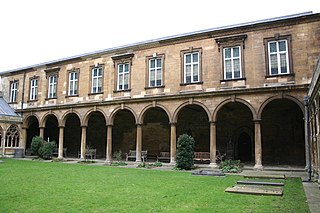
The Lincoln Cathedral Library is a library of Lincoln Cathedral in Lincolnshire, England. It is housed in a building designed by Christopher Wren.
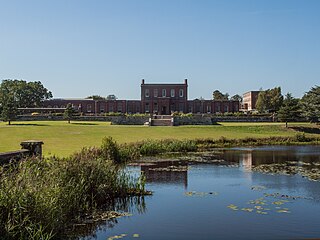
Ashburnham Place is an English country house, now used as a Christian conference and prayer centre, five miles west of Battle, East Sussex. It was one of the finest houses in the southeast of England in its heyday, but much of the structure was demolished in 1959, and only a drastically reduced part of the building now remains standing.
Chester Cathedral Library is situated in three rooms in and around the cathedral in Chester, Cheshire, England. It has been in existence since the time of St Werburgh's Abbey, the predecessor of the cathedral. The library was previously housed mainly in the chapter house of the cathedral, then in a room above the former King's School. During the 2000s it was refurbished and partly rehoused. It is available for study and research, and is open for visits by organised groups.
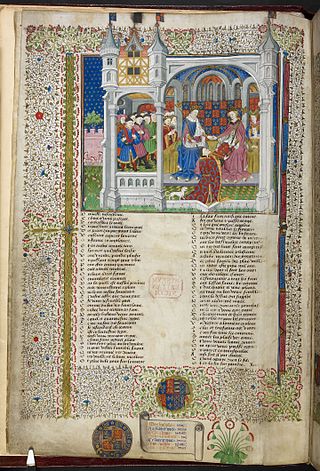
The Royal manuscripts are one of the "closed collections" of the British Library, consisting of some 2,000 manuscripts collected by the sovereigns of England in the "Old Royal Library" and given to the British Museum by George II in 1757. They are still catalogued with call numbers using the prefix "Royal" in the style "Royal MS 2. B. V". As a collection, the Royal manuscripts date back to Edward IV, though many earlier manuscripts were added to the collection before it was donated. Though the collection was therefore formed entirely after the invention of printing, luxury illuminated manuscripts continued to be commissioned by royalty in England as elsewhere until well into the 16th century. The collection was expanded under Henry VIII by confiscations in the Dissolution of the Monasteries and after the falls of Henry's ministers Cardinal Wolsey and Thomas Cromwell. Many older manuscripts were presented to monarchs as gifts; perhaps the most important manuscript in the collection, the Codex Alexandrinus, was presented to Charles I in recognition of the diplomatic efforts of his father James I to help the Eastern Orthodox churches under the rule of the Ottoman Empire. The date and means of entry into the collection can only be guessed at in many if not most cases. Now the collection is closed in the sense that no new items have been added to it since it was donated to the nation.

Perpendicular Gothic architecture was the third and final style of English Gothic architecture developed in the Kingdom of England during the Late Middle Ages, typified by large windows, four-centred arches, straight vertical and horizontal lines in the tracery, and regular arch-topped rectangular panelling. Perpendicular was the prevailing style of Late Gothic architecture in England from the 14th century to the 17th century. Perpendicular was unique to the country: no equivalent arose in Continental Europe or elsewhere in the British Isles. Of all the Gothic architectural styles, Perpendicular was the first to experience a second wave of popularity from the 18th century on in Gothic Revival architecture.
